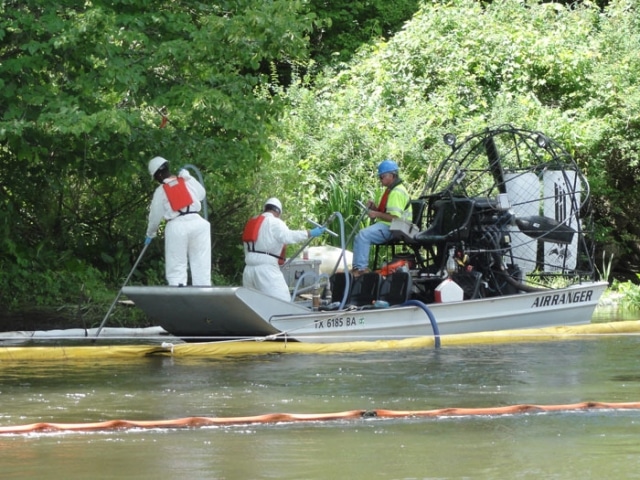Last week marked the third anniversary of the largest inland oil spill in US history. On July 25th, 2010 a 41-year old Enbridge pipeline in Michigan tore open spewing over three million litres of diluted tar sands bitumen or dilbit from Alberta into the Kalamazoo River and the surrounding area. Three years later the spill from the Enbridge pipeline known as Line 6B is still being cleaned up with the cost nearing one billion US dollars.
The Kalamazoo spill drew wide spread attention to the dangers of shipping dilbit through North America’s oil pipeline system. Now environmental organizations and residents of Ontario and Quebec fear Enbridge’s plan to ship dilbit from Sarnia, Ontario to Montreal, Quebec through the 37-year old Line 9 pipeline. They worry this will put their communities at the centre of the next ‘dilbit disaster.’
“What happened at Kalamazoo could happen here with Line 9,” says Sabrina Bowman a climate campaigner with Environmental Defence based in Toronto.
“People in Ontario and Quebec need to know the Line 9 pipeline is very similar in age and design to the ruptured Line 6B in Kalamazoo,” Bowman told DeSmog Canada.
In a previous article, DeSmog revealed Line 9 and Line 6B share the same design deficiencies. Line 9 is covered in the same outdated protective coating called polyethylene tape or PE-tape that caused the Kalamazoo spill. PE-tape became unglued from Line 6B allowing water to corrode the pipe and resulting in the pipeline’s rupture. The problems with PE-tape have been known by the pipeline industry for at least six years.
“The Kalamazoo spill took place in a municipality where 7000 people live. Line 9 on the other hand passes through major urban centres such as Toronto or Montreal where millions live,” says Steven Guilbeault, director of Equiterre in Montreal.
Line 9 runs through the most densely populated area of Canada and comes within kilometres of Lake Ontario. It crosses the Ottawa and St. Lawrence rivers.
“A Line 9 dilbit spill could affect tens of thousands of Canadians,” Guilbeault told DeSmog.
Dilbit spills behave differently than conventional oil spills where bodies of water are involved. Unlike conventional oil, which floats on top of water, dilbit sinks.
“A conventional oil spill usually involves scooping the oil off the water’s surface and maybe some removal of the river banks. Dilbit spills involve dredging rivers,” says Keith Stewart, a climate and energy campaigner with Greenpeace Canada.
The US Environmental Protection Agency (EPA) ordered Enbridge to dredge three sections of the Kalamazoo River earlier this year citing nearly 720 000 litres of bitumen are still in the riverbed. Upon completion of this round of dredging at the end of this year the EPA will have to decide if further dredging is necessary or if the remaining bitumen should be left in the river.
“What’s worse: having some residual oil in the river, or damaging the river trying to get it out?” said Ralph Dollhopf of the EPA in the Detroit Free Press last June.
The dredging operations are a new cause of anxiety for local residents affected by the Kalamazoo spill. They claim the site Enbridge selected for its dredging pad – the site where dredged materials from the Kalamazoo will be collected and water and contaminants separated – is too close to local businesses and homes for comfort. Residents fear contaminants may seep into the groundwater or be released into the air during this process.
Local residents are already suffering from ‘cleanup fatigue’; weary from the seemingly never-ending remediation of the Kalamazoo spill. Many are concerned they will never get answers as to what the long-term consequences of the spill on their health are.
“There is very little knowledge about how exposure to the hundreds of chemicals in oil, let alone tar sands oil, affects human health. Many residents face significant anxiety everyday about this unknown. How will their health and their children’s health be impacted ten years down the road?” says Sonia Grant, a University of Toronto graduate student conducting field research at ‘ground zero’ of the Kalamazoo spill.
The thick and viscous bitumen must be diluted with a condensate in order for it to run through pipelines. This condensate is a chemical cocktail known to carry carcinogens such as benzene. The condensate separates from the bitumen when dilbit comes in contact with water. The bitumen sinks and the condensate forms what amounts to a toxic cloud. Residents suffered from headaches, skin rashes, nausea and breathing problems in the immediate aftermath of the Kalamazoo spill.
The US Department of Health and Human Services refuses to do a long-term health risks study on those affected by the spill.
“Kalamazoo has shown us dilbit spills are more harmful than conventional oil spills,” Greenpeace Canada’s Stewart told DeSmog.
The National Energy Board (NEB) – Canada’s independent energy regulator – is still deliberating on Enbridge’s proposal to ship dilbit through Line 9. Public hearings will most likely take place in October. The NEB could make a final decision on Line 9 as early as January 2014.
Kalamazoo spill commemoration events were held in Sarnia, Kingston and Montreal on the weekend.
Image Credit: EPA
Subscribe to our newsletter
Stay up to date with DeSmog news and alerts






